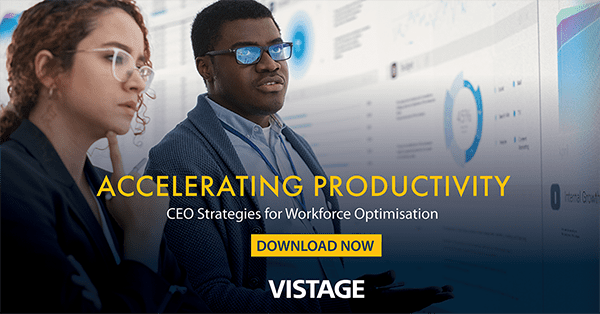You are here: Home / Leadership Insights / Business Operations / Overcoming inhibitors to productivity: 4 strategies for CEOs [New report]

Overcoming inhibitors to productivity: 4 strategies for CEOs [New report]

While this article is drawn from insights in the US market, the productivity inhibitors it highlights—talent shortages, slow digital transformation, hybrid work, and skills gaps—are equally relevant to Australian and New Zealand business leaders.
After investing heavily in their workforce in a relatively stable economy, CEOs have turned their attention to realising a return on their investment by improving workforce productivity.
Measured by a variety of metrics, including revenue per employee, utilisation/billable hours or units or output per hour, improving productivity within and across the organisation is a CEO strategy. According to the Q3 Vistage CEO Confidence Index survey, 37% of small and midsize business CEOs say they have seen improved productivity over the past year. While 12% experienced a decrease. When comparing the sentiment of the 37% of respondents that reported improved productivity compared to those with stable or decreasing productivity, our analysis reveals that those with increased productivity also expect increased revenues, improving profitability and have seen an increase in employee retention.

Improving productivity is a powerful growth lever, organisational differentiator and direct contributor to a business’s valuation.
Get the report. Accelerating Productivity: CEO Strategies for Workforce Optimisation
However, investing in productivity alone is not enough; successful implementation, execution and a cultural embrace are essential to continuous improvement. As the economy shifts into the upcoming growth cycle, CEOs who’ve made investments in productivity will be first in line. However those who have not will struggle to catch up.
How can CEOs address productivity to optimise their workforce for the upcoming growth cycle? The latest report from Vistage Research, Accelerating Productivity: CEO Strategies for Workforce Optimisation[c], explores the top factors that hinder productivity and the strategies that enhance it. It draws insights from our recent survey of CEOs and expert perspectives gathered from the Vistage community.
Our analysis of data from over 1,600 CEOs distilled the 4 biggest inhibitors to productivity among small and midsize businesses.
1. Talent Shortage
The ongoing shortage of more qualified, skilled workers remains a top challenge in today’s business environment. To meet the demands of today’s workforce and scale for the future, companies must have adequate training and development resources to upskill their team. This demand will only increase as the Baby Boomer generation continues to exit the workforce and Gen Z tries to fill in the gaps.
Some CEOs view employee development as a necessary investment and recognise the long-term benefits. “We are investing in training, which may limit short-term production, but will benefit our long-term success,” says Carrie Nicholson, President of Accurate Infrastructure Data Inc. in Baltimore, Maryland. “Our main production and growth inhibitors are finding and hiring the right candidates.”
2. Slow Digital Transformation
In the digital era, companies must stay agile by upgrading their systems and improving user adoption to improve productivity. Even though technology utilisation and adoption are a continuous challenge, CEOs are increasingly interested in investing in AI. 55% of CEOs report investing in automation, with another 22% planning to invest. As digital transformation quickens, companies that delay adopting modern technology risk falling behind, missing out on the efficiencies and innovations it can bring.
Digital workers are at the intersection of this slow transformation and the talent shortage mentioned earlier. They are computers trained to execute manual and repetitive tasks, such as taking customer orders and entering data. According to Mark Shivers, CEO of Ignite IPA, digital workers are the best alternative to eliminating human error and inefficiencies. Why?
- Digital workers do not make mistakes. Digital workers are trained to do a process over and over, eliminating manual and mundane tasks. They can be trained on a workflow where they know all the rules for processing a transaction. The only way you can have less than 100% is if the person building the digital worker or automation solution builds it incorrectly.
- Digital workers cost about 1/3 to 2/3 of what a human worker costs. This helps companies benefit from faster processing times and bottom-line savings.
- Digital workers help scale a business at a higher margin and enable companies to redeploy people to more challenging and fulfilling roles. They allow management to focus on growing and scaling the business rather than adding oversight for a new crop of untrained resources. They help improve employee retention by allowing people to focus more on thinking, supporting customers and being creative.
3. Hybrid Work
Once seen as the ideal solution during the pandemic, the hybrid workplace model is now facing increased scrutiny. While hybrid provided flexibility during the pandemic, some believe it hinders the creativity and problem-solving that often come from in-person collaboration and weakens workplace culture.
To address these challenges, some leaders, like Bill Wood, President of Salto Systems Inc. in Norcross, Georgia, are refining remote work practices for greater effectiveness. Specifically, Wood says his company is “adapting employee development and engagement strategies to support better work-from-home performance metrics.”
4. Insufficient Skills
When individuals achieve their goals, this performance aggregates to the workgroup and ultimately causes the entire organisation to hum. Insufficient skills can be seen at all levels, from a new employee needing coaching to a tenured employee resisting new technology or lacking leadership skills among the management team. Training and professional development are key investments to improve productivity. While the effects may be seen later, investing in people ensures long-term success.
For these initiatives to succeed, organisations must foster a culture of learning, adaptability and continuous improvement. By upskilling and developing people, small and midsize businesses can overcome talent shortages, accelerate technology adoption and evolve workplace dynamics.
To learn more about how leaders are addressing productivity today and expand your perspectives with insights from trusted experts in the community, download our latest report. “Accelerating Productivity: CEO Strategies for Workforce Optimisation.”
In this report, you will:
- Understand how to address the key inhibitors to productivity and optimise your workforce.
- Gain expert perspectives from top productivity and workforce experts who are trusted speakers in the Vistage community.
- Learn actionable takeaways that you can implement now to boost workplace culture, develop talent, streamline processes and leverage new technologies like AI.
- Ensure you build a business that is ready to take on the next growth cycle.
Related Resources
Q3 2024 CEO Confidence Index Report
Originally published on Vistage Research Center.




